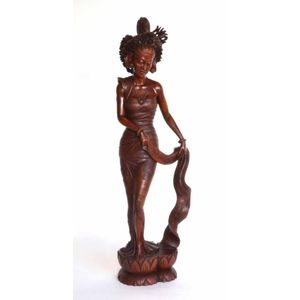Lotus Lady Bronze Figurine by Milo in Art Nouveau Style
You must be a subscriber, and be logged in to view price and dealer details.
Subscribe Now to view actual auction price for this item
When you subscribe, you have the option of setting the currency in which to display prices to $Au, $US, $NZ or Stg.
- Art Nouveau Period - The Art Nouveau period was a cultural movement that emerged in the late 19th century, and was characterized by its emphasis on natural forms, flowing lines, and a decorative, ornamental style. Art Nouveau was a reaction against the ornate and heavily stylized designs of the previous era, and sought to create a new, more organic aesthetic.
Art Nouveau was characterized by its use of sinuous, curving lines, as well as a focus on natural elements such as flowers, vines, and other organic shapes. Art Nouveau designers sought to create a total work of art, in which every element of a building or object was designed to be harmonious with the overall design.
Some of the most iconic examples of Art Nouveau design include the Paris Metro entrances designed by Hector Guimard, the works of the artist Alphonse Mucha, and the architecture of Victor Horta in Brussels.
The Art Nouveau period was at its peak between 1890 and 1910, but began to decline in popularity by the start of World War I. However, Art Nouveau remains an important influence on design and art to this day, and continues to be celebrated for its emphasis on natural forms and decorative style. - Incised - A record of a name, date or inscription, or a decoration scratched into a surface, usually of a glass or ceramic item with a blunt instrument to make a coarse indentation. Compare with engraving where the surface is cut with a sharp instrument such as a metal needle or rotating tool to achieve a fine indentation.
- Bronze - An alloy of copper and tin, traditionally in the proportions of about 9 parts of copper to 1 part of tin.
The discovery of bronze in Western Asia in the 4th century enabled people to create metal objects which were superior to those previoulsy possible because of its strength and hardness, and it has been used throughout the world for weapons, coins, tools, statuary and other decorative items.
It is very fluid in a molten state, and its hardness, strength when set, and non-corrosive properties makes it most suitable for casting sculpture.
This item has been included into following indexes:
Visually similar items

A carved wood Balinese dancer sculpture, mid 20th century, by FA pan Akus of Bali, signed under base. Note: FA pan Akus is a noted master carver in Bali. Height 114.5 cm. Provenance: Presented as a gift by President of Indonesia, to lady. Hasluck, wife of

An Alphonse de Tomba bronze figure (Belgium 1843-1918) 'Improvisateur', signed Alp De Tomba, Foundry H. Luppens. Height 71 cm

A 20th century Post-Revolution Chinese rosewood figure, depicting a young woman standing in heroic pose in an agricultural costume beside a pot and book. Height 26.5 cm

Antique patinated bronze figure group, titled Danseurs Napolitains, signed E Gossin?, approx 62 cm high
